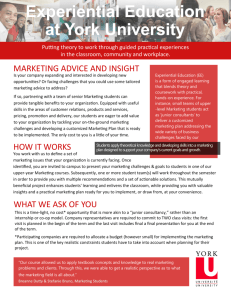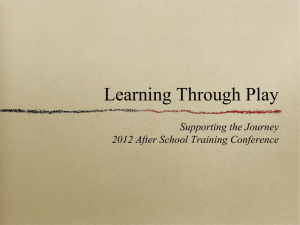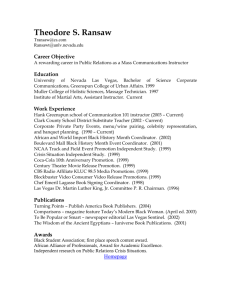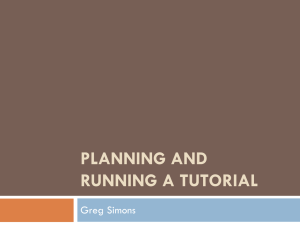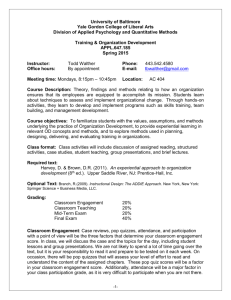creative teams: a marketing concept training activity
advertisement
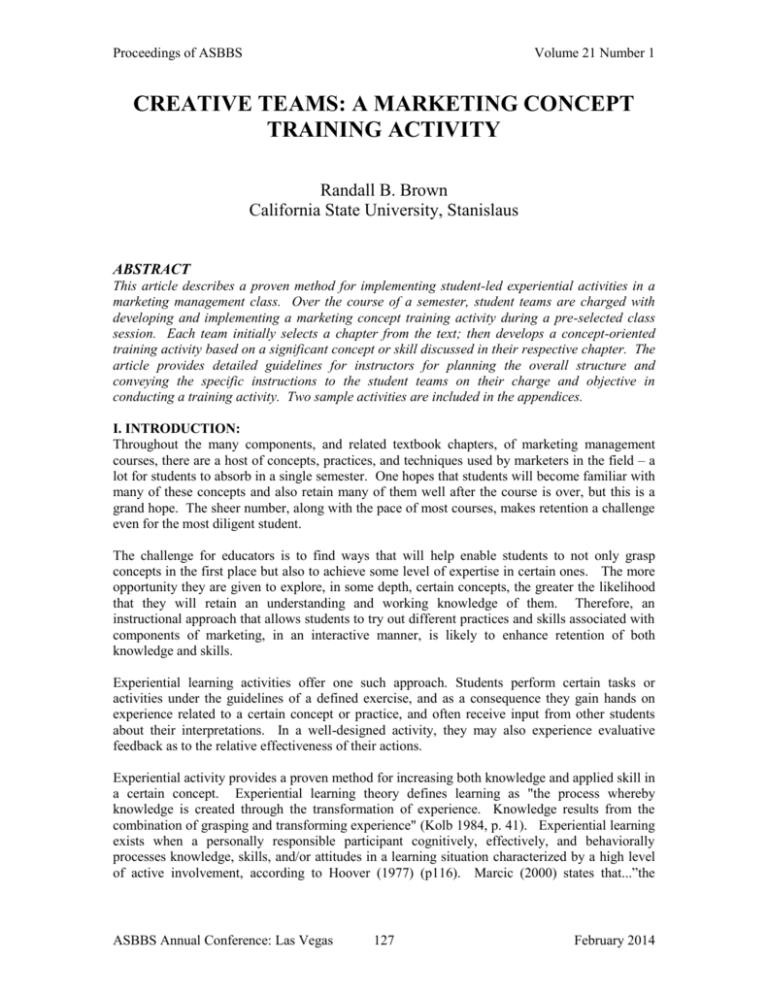
Proceedings of ASBBS Volume 21 Number 1 CREATIVE TEAMS: A MARKETING CONCEPT TRAINING ACTIVITY Randall B. Brown California State University, Stanislaus ABSTRACT This article describes a proven method for implementing student-led experiential activities in a marketing management class. Over the course of a semester, student teams are charged with developing and implementing a marketing concept training activity during a pre-selected class session. Each team initially selects a chapter from the text; then develops a concept-oriented training activity based on a significant concept or skill discussed in their respective chapter. The article provides detailed guidelines for instructors for planning the overall structure and conveying the specific instructions to the student teams on their charge and objective in conducting a training activity. Two sample activities are included in the appendices. I. INTRODUCTION: Throughout the many components, and related textbook chapters, of marketing management courses, there are a host of concepts, practices, and techniques used by marketers in the field – a lot for students to absorb in a single semester. One hopes that students will become familiar with many of these concepts and also retain many of them well after the course is over, but this is a grand hope. The sheer number, along with the pace of most courses, makes retention a challenge even for the most diligent student. The challenge for educators is to find ways that will help enable students to not only grasp concepts in the first place but also to achieve some level of expertise in certain ones. The more opportunity they are given to explore, in some depth, certain concepts, the greater the likelihood that they will retain an understanding and working knowledge of them. Therefore, an instructional approach that allows students to try out different practices and skills associated with components of marketing, in an interactive manner, is likely to enhance retention of both knowledge and skills. Experiential learning activities offer one such approach. Students perform certain tasks or activities under the guidelines of a defined exercise, and as a consequence they gain hands on experience related to a certain concept or practice, and often receive input from other students about their interpretations. In a well-designed activity, they may also experience evaluative feedback as to the relative effectiveness of their actions. Experiential activity provides a proven method for increasing both knowledge and applied skill in a certain concept. Experiential learning theory defines learning as "the process whereby knowledge is created through the transformation of experience. Knowledge results from the combination of grasping and transforming experience" (Kolb 1984, p. 41). Experiential learning exists when a personally responsible participant cognitively, effectively, and behaviorally processes knowledge, skills, and/or attitudes in a learning situation characterized by a high level of active involvement, according to Hoover (1977) (p116). Marcic (2000) states that...”the ASBBS Annual Conference: Las Vegas 127 February 2014 Proceedings of ASBBS Volume 21 Number 1 unique feature of experiential learning is that it requires the student to become involved effectively and behaviorally with the material” (p.3). The general idea behind the use of experiential learning is to provide students an opportunity to test concepts and practices that they have become familiar with, in some variety of interactive process directed towards a specific learning objective (knowledge, skill, and practice). Often, graduates are well versed in theory and terminology and certain technical skills, but weak in the interactive, problem-solving skills and practices that are more likely to enable them to succeed in a work environment (Bowen, Lewicki, Hall, and Hall, 1996). In a classroom setting, experiential learning can be well structured and delivered through an activity or exercise that directly involves all members of a class, for a pre-determined period of time, and with pre-determined objectives. Through these processes, linked to course material and course learning objective, students are better able to acquire in-depth familiarity with a concept or practice, again in this case in the area of marketing. Hence a need exists for well-crafted experiential learning or activity-based educational techniques and methods. II. ACTIVITY METHOD OPTIONS Such class-delivered activities are generally concept or topic-based. The instructor serves as the planner and facilitator of the activity. The students involve themselves to whatever extent the activity calls for, in combination with their interest in the topic and willingness to participate in a thoughtful manner. A variation of this process (second option) calls for student-led learning activities in which small teams of students are assigned an activity, or adopt one from some source or book. Under the guidance of the instructor, the students then act as presenters and facilitators of the activity, following pre-established guidelines that direct the activity towards certain learning objectives. Because of time demands with this approach, the practice works best when it is spread over several class sessions, with each team assigned a particular class session. In addition to the focal topic or concept, well-constructed activities are learning-goal based, and thus should be set-up and executed in a manner that facilitates the achievement of these goals. In the instructor led model, learning goals are pre-determined either by the developer of the activity, if it is one taken from a book or manual or by the instructor if the activity is instructor designed. If the activity is then carried out in the prescribed or intended manner, there is high chance of learning goal achievement. In the case of student led activities, the goals may similarly be advanced, especially if student teams are charged with leading established, time-tested activities and execute them in the prescribed manner. A third classroom option involves having student teams both design and lead the experiential activity. In this approach, students are given directions as to the nature and purpose of the activity to be designed, including the overarching goal -- such as training participants in a particular area of knowledge or skill. It is also useful, from the instructor’s point of view, to provide a structural outline. Employing this approach in a course adds a two tier learning goal to the process: (1) on the one hand, the learning goal of the activity itself, which pertains to the other members of the class., (2) on the other hand, the learning goal for the student team leading the activity, which is skill-building in the development and execution of an activity – essentially skills related to concept training: planning, implementing, and summarizing an activity oriented towards a selected concept or topic. For the learning/training goal pertaining to members of the class (audience), the importance of establishing such goals need to be conveyed in the instructions that are disseminated to all student teams prior to planning and preparation of an activity (see Appendix A). These instructions ASBBS Annual Conference: Las Vegas 128 February 2014 Proceedings of ASBBS Volume 21 Number 1 should clearly lay out the charge to the student teams in terms of developing learning objectives for the members of the class, when they enact the experiential activity. A more advanced model of student led activities is also possible -- one calling for an assessment of learning following the activity – however this is not only challenging but can be quite timeconsuming. One reasonably efficient means of doing such is through the use of a brief survey that is distributed after the activity is completed. One which seeks both ratings of the activity, and feedback on content, may to a certain extent suffice, if questions are carefully oriented to learning goals. The “marketing concept training activity”, described herein, reflects this latter model of experiential activity aimed at both furthering students’ skills in some particular marketing concept and developing student skills in planning and leading a training activity for the other students in the class. As such, it has the aforementioned two-tier learning goals, and is an extremely effective manner to enhance the overall learning of students in a marketing class towards various marketing concepts while at the same time helping students to develop their planning, presentation, and facilitation skills. The framework for the activity is established at the outset of a course, and included in the syllabus (Appendix A). Over the course of a semester, all student teams – in pre-selected class periods -- are provided the opportunity to participate in the planning, development, and execution of a concept training activity. In addition, all students are participants in the activities planned and executed by the other groups. Activities are topic based and generally planned to be 35-45 minutes in duration. The marketing concept training activity is a team-based activity suitable for a marketing management class at either the undergraduate or graduate level. It is best suited to a course that is accompanied by a marketing textbook, as the various chapters in the text book provide both the source for the focal concepts and sufficient variety of concepts for different student groups to choose from and base their activity on. Over the course of a 15 or 16 week semester, teams of 35 students are charged with selecting a concept to base an activity upon, and then planning, developing, and executing the activity during a set time period in an assigned class. III. ASBBS PRESENTATION OUTLINE 1. Introduction: brief background of this activity and how it may be implemented in a semester long course. 2. Sample activity: session participants will be given an activity to carry out, in a shortened version of a classroom session activity (see Appendix B) 3. Conclusion and discussion: participants will be asked for their comments and feedback on the perceived effectiveness of the activity and how it might be altered or otherwise improved. Handouts will consist of the two appendices: (1) The syllabus component describing, in detail, the assignment and charge to the student teams, including the ratings and feedback sheet that students fill out after each student-led activity. (2) Two samples of activities that a student team could develop and implement in a 35-40 minute class time period. APPENDIX A Marketing Concept Training Activity (included in the course syllabus) ASBBS Annual Conference: Las Vegas 129 February 2014 Proceedings of ASBBS Volume 21 Number 1 Each team will lead a Marketing Concept Training Activity on an assigned week during the semester. The learning goal of the activity is to train the class in the understanding and application of a particular marketing concept – one that is identified and described in a chapter of the text that the team will select in week two. The idea is to select a concept – a topic or component of a chosen chapter – and take the concept a step further than its description in the book with the purpose of conveying to the audience (the class) an in-depth understanding of the concept at the end of the training activity, and an enhanced skill in applying the concept in both case analyses and, possibly, in a real-world marketing situation. 1. The first step, for each team, is to select the chapter of the textbook and the concept therein that you wish to focus on. The concept should be something that is covered in the chapter for the week in which the activity will take place (see course schedule). With that in mind, the chapter selection process will take place during the second week of class. Assigned teams will first consider the titles of the text chapters and which chapter or chapters they might want to draw on for a centerpiece concept. The chapter selection process will then take place. Once all teams have selected a chapter, the schedule for activities will automatically be established, in accordance with the syllabus, and team members can begin to narrow their focus to some topic or concept thing within the selected chapter that would seem to be a valuable concept for the audience to receive further training and skill in. Keep in mind a difference between “education” and “training”. Education pertains more to providing wide breadth of information about a particular area or aspect of marketing (in this case). A chapter in the text is primarily knowledge/education-oriented. Training/ skill development takes a narrower, more focused approach. The objective of training is to take one component from some defined area of marketing and train people both to understand and be able to apply skills in this area. (e.g. Chapter 9 “Personal Selling...”: While it wouldn’t be appropriate to try to train people in the class to be adept salespersons, it might be appropriate to train them to be aware and knowledgeable in one or two aspects of being a competent salesperson, e.g.: how to prospecting, plan sales calls, handle objections, or negotiate. Or Chapter 2 “Marketing Research”: What are some aspects of market research – such as planning a focus group to gain information on a selected product, or “data-mining” processes, or personal in-depth interviewing – that individuals could be trained in?) Important: The Marketing Concept Training Activity is not intended to be a presentation of material that is already in the text. In the week that your group does its presentation, the class will have already read the text material and be somewhat familiar with the concept. Your objective is to design a way in which members of the audience can become versed in both the understanding and the application of the concept. (e.g. If you were using Chapter #7 – New Product Planning and Development – one option might be to bring in a new product, or a description thereof, and have the class, working in teams, devise a brief marketing plan for the new product that included the target market, the marketing mix, and an idea for an initial launch. If using chapter # 8, an activity could be designed around the concept of persuasion in advertising: what are the bases of persuasion and persuasive messages, how do different ads use such in their messages, etc.). Keep in mind that your goal is to train and enlighten class members, not inundate them with facts, figures, and an excess of information that they will likely forget as soon as the class is concluded (see the “activity evaluation sheet” for criteria on how the activity will be rated by the audience). With that in mind, please limit your use of PowerPoint or other presentation technique to no more than 5-7 minutes of the activity. ASBBS Annual Conference: Las Vegas 130 February 2014 Proceedings of ASBBS Volume 21 Number 1 A suggested outline for the activity is as follows: 1. Introduction: The team introduces itself and the selected topic (5-6 minutes). A brief summary of the concept, including terms and definitions, is often appropriate during this stage. Although the rest of the class has read the material in the assigned chapter, it is useful to familiarize them with both the topic at hand and how the topic fits with the overall topic of the chapter from which it is taken. 2. Activity: The team instructs the members of the class in what they would have them do and the structure in which they should proceed (e.g. individually, in pairs, small groups, large groups). Instructions and objectives should be described both verbally and in writing for purposes of specificity and clarity. Written guidelines can either be displayed on a screen at the front of the class or handed out (to individuals or groups) or some combination thereof. Along with the instructions and objectives, timelines should also be communicated. 3. Summary: Review of the topic or concept and brief statement of the learning or training objectives. Time permitting, team members may want to ask members of the class what they gained from the activity. The time frame for an activity is 35-40 minutes. In planning the activity, please touch base with me so that I can keep abreast of what different teams are planning and help to ensure that selected concepts are not too similar to others, or overlap them. The actual structure that you use is up to you as a group. I will critique the first two activities in order to provide further guidance to the successive groups. APPENDIX B Two Examples of Student Developed Marketing Concept Activities 1. The Market Research Activity Format: The class is divided into groups of three by the presenting team. The following instructions are then presented: “Your assigned group is the new Brand Management Team for the product that you have selected”. (Note: 8-10 common household products have been brought in and displayed on a table up front). “As the Brand Management Team, part of your job is to find ways to enhance the competitive position of your product in the marketplace, with certain goals in mind such as, (1) building market share, (2) increasing sales, (3) increasing profit margin, (4) finding new markets, etc.” “In connection with these goal and brand marketing strategy, it would benefit to you to know more about how your product is perceived, compared & evaluated, and used by target consumers. Due to reduced marketing budgets, you have been limited to conducting a small number of focus groups for the market research component of the budget, the aim of which is to improve the market strategy for this product and achieve results”. Three copies of the following handout are then given to each group of three: Step 1. Plan a focus group of 6 consumers: a. Identify the primary target consumer. Develop a profile of the primary Target Consumer (a priori segmentation). In so doing, use up to 3 demographic & 1 psychographic dimension. b. Why do you think they purchase this product (not brand necessarily)? That is, what benefits. c. Select the balance: four persons from the primary group, and two others (secondary consumers) who you feel could add good information. Who are the two “others”? ASBBS Annual Conference: Las Vegas 131 February 2014 Proceedings of ASBBS Volume 21 Number 1 d. How many of the six persons (if any) will be people who have previously used your brand of the product? Why this number? Step 2: What is about consumer habits, perceptions, comparisons, decisions, etc. that you would like to know more about, as pertains to the brand selection, purchase, and usage of your product. Write down a short list of issues or topics of interest. In developing this list, be thinking of your marketing mix (Product design including packaging, Price, Promotion and Place), and how you might use information gained from the focus group to make adjustments or changes to this mix that would enhance the success of your brand. Step 3: Now make-up a list of no more than 6-8 specific questions or topics for your focus group, based on the issues and topics above. These are the specific topics you want them to discuss and respond to. Activity Summary (by the presenting team). What is the purpose of market research that is being conducted on an existing product? Although purpose may vary depending upon specific situations (product, goals, life-cycle etc), certain generic research aims include: 1. Who are our customers? Who (customer profile) is buying and using our product? 1a. Is there more than one significant market segment? 2. What are their needs and wants in a product like ours? 3. What ultimate benefits might they be wanting from a product like ours? 4. To what extent is our current product, as currently marketed, meeting these needs and providing the benefits? 5. What actions should we take, regarding the full marketing mix of this product, to better meet the needs and wants of our target consumer(s) and provide extended benefits? 6. Should we consider a variation on this marketing mix to meet the needs and wants of a secondary segment? 7. How can we measure the results of any changes we make in the marketing mix as a result of research? 2. The Product Positioning Training Activity Format: The class is divided into groups of four students by the presenting team. Groups are told that they will be assigned either a company product line or an industry product. Their assignment will be to develop a “product positioning map” for the product line that that will be assigned to them. Introduction: The presenting team delivers a brief overview of “product positioning”, in connection with the textbook chapter on market segmentation, and how the concept is applied to target market segments of consumers for various consumer products. This short presentation includes the five basic positioning strategies that companies may choose from including ones based on attributes, use or application, product uses, product class, and competitive products. The team presents the class with a sample product positioning map, in this case one from the textbook on automobiles, explaining the two dimensions on the map (in this case “luxurious versus functional” and “traditional versus sporty”), why these dimensions, or factors, were selected, and why different products (cars) were positioned as they were on the map, that is to match the needs and wants of different consumer segments. The team then assigns each group either a product line within a company (e.g. Kellogg cereals, Mars candy bars, Proctor and Gamble laundry detergents) or a product type common to several ASBBS Annual Conference: Las Vegas 132 February 2014 Proceedings of ASBBS Volume 21 Number 1 companies (e.g. credit cards, soft drinks, coffee). In both cases, the teams are given a list of product names – 7 or 8 – that they are to think about and eventually position on a two dimensional map. Their assignment is: (1) to first discuss and decide upon the two factors that they will use on their map, along with the two “sides” of each factor; (2) to position the 7 or 8 products that they have been given on the map; (3) be able to explain their rationale to the class both for the factors that they selected and for how they positioned 2 or 3 of the products on their map. (For purposes of the group mini-presentations, it is useful for the presenting team to have a pre-determined method for display of the maps to the rest of the class – e.g. paper charts or an Iphone picture). (4) finally, to briefly explain how they might price and promote one product to its target segment. REFERENCES Bowen, D. B., Lewicki, R. J., Hall, F. S. and Hall, D.T. (1996). “Experiences in Management and Organizational Behavior”. John Wiley & Sons: New York Hoover, D. J. (1977). “Experiential Learning: Conceptualization and Definition”. In R.E.Horn (ed) The Guide to Simulations/Games for Education and Training. 3rd edition, vol 2). Didactic Systems Inc: Cranford, NJ. Kolb, D.A. (1984). “Experiential learning: experience as the source of learning and development. Englewood Cliffs, NJ: Prentice Hall. Marcic, D. (2000). “Organizational Behavior: Experience and Cases”. Thomas South-Western: Mason, OH ASBBS Annual Conference: Las Vegas 133 February 2014
